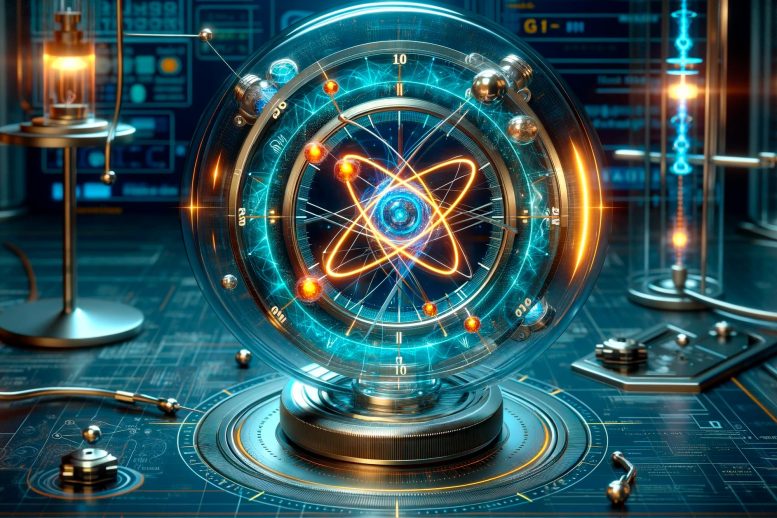
An international research team is advancing precision timekeeping by developing a nuclear clock using thorium isotopes and innovative laser methods, potentially transforming our understanding of physical constants and dark matter. (Artist’s concept.) Credit: SciTechDaily.com
A new and more precise way of measuring time is the aim of an international research project in which Würzburg physicist Adriana Pálffy-Buß is involved. The results could also help in the search for dark matter.
The global navigation system GPS, digital data traffic in the telephone network, measuring the earth from satellites: All these technologies would not work without precise timekeepers. Here, a few billionths of a second are crucial for the results to be correct. Science – especially physics – is also dependent on extremely precise clocks if it wants to find out, for example, what dark matter is made of or whether natural constants are actually constant.
A fundamentally new basis for such a high-precision timepiece is the focus of an international research project that has now been approved. At the end of 2023, the Austrian Science Fund FWF has set up a so-called “Special Research Area” for this purpose, comparable to a Collaborative Research Centre of the German Research Foundation (DFG).
Over the next four years, teams from the University of Vienna and the Vienna University of Technology, the Institute of Science and Technology Austria and Julius-Maximilians-Universität Würzburg (JMU) will be working together on the project, which is funded with 3.1 million euros. Adriana Pálffy-Buß is involved in the project from Würzburg. The expert in X-ray quantum optics took over the professorship for Theoretical Quantum Information and Quantum Optics at JMU at the beginning of 2022. With her group, she also conducts research in the Würzburg-Dresden Cluster of Excellence ct.qmat – Complexity and Topology in Quantum Materials.
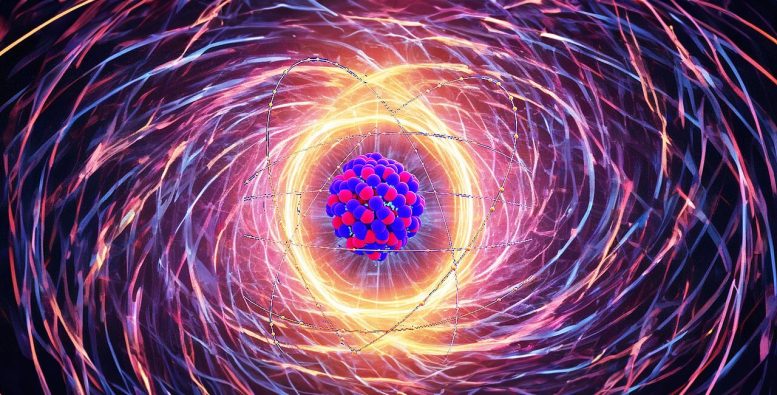
The jump of a thorium nucleus from the excited to the ground state is the starting point of a new type of clock that research teams from Würzburg and Vienna want to develop. Credit: Oselote / iStockphoto (Atomkern) /KI Hintergrund), Edited
Increasing the Measurement Accuracy of Physical Methods
“Researchers led by Oliver Heckl from the University of Vienna want to increase the measurement accuracy of physical methods in the special research area ‘Coherent Metrology beyond Electric Dipole Transitions’. An innovative method that uses light with orbital angular momentum will be used,” according to the FWF press release. What does this mean?
“The most precise timekeepers today are atomic clocks, which measure time based on the frequency of the transitions that electrons make between the different energy levels of an atom. In our project, we want to use a newly developed narrow-band laser to make an atomic nucleus jump between energy levels and emit photons, i.e. particles of light, in the process. Such a nuclear clock could increase measurement accuracy by a factor of about 3,” explains Adriana Pálffy-Buß.
Research on an Isotope of the Element Thorium
The research team is focusing on an isotope of the element thorium. The thorium nucleus in question has 229 nuclear building blocks – protons and neutrons – and can reach an excited state that is only around eight electron volts more energetic than its lowest energy state, the so-called ground state.
“This difference is so tiny by the standards of nuclear physics that the two states were barely distinguishable when they were first observed,” says Pálffy-Buß. At the same time, it is this difference that could make a “nuclear time measurement” possible. Experimental proof of this jump from the excited to the ground state of a thorium nucleus with the emission of a photon was achieved in 2023.
Shoot thorium atoms with a laser and capture the photons you are looking for: Unfortunately, the “nuclear clock” doesn’t work that easily. One of the reasons for this: “You need around eight electron volts to excite the nucleus. However, six electron volts are enough to remove the outermost electron from its orbit. In this case, the excited nucleus prefers to transfer its surplus energy to the electron instead of emitting a photon. However, this must be avoided,” explains the physicist.
The solution to this problem could be to incorporate thorium atoms into special transparent crystals. “The corresponding experiments showed that thorium takes its place in the crystal lattice in an ionic state – in other words, it gives up its outer electron,” explains Pálffy-Buß. The crystal can also host many thorium nuclei at once, which makes it easier to detect the photon being sought.
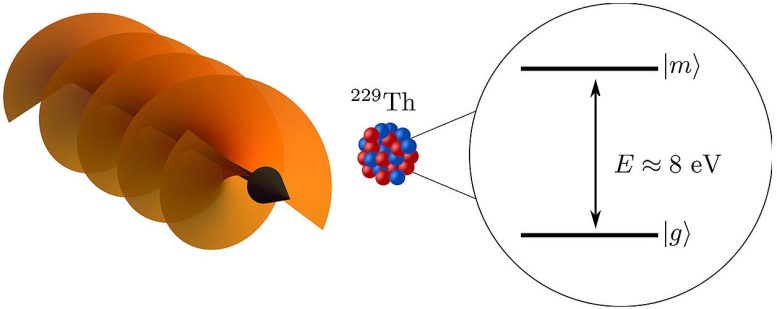
Laser pulses in the form of a rotating corkscrew are intended to bring the thorium nuclei into the desired excited state. Credit: Tobias Kirschbaum
Rotating Corkscrews As Solution
Another problem: to date, there is no laser with the necessary precision to trigger the desired effect. The Austrian-German research team is therefore relying on the aforementioned “innovative method that uses light with orbital angular momentum.” This is also referred to as twisted light or vortex beams.
In very simplified terms, laser pulses do not hit the thorium atoms like an “energy wall” in this method. Instead, they resemble a kind of rotating corkscrew and are therefore more likely to put the atomic nuclei into the desired excited state.
Theory Calculations for the Ideal Scenario
As an expert in theoretical physics, Adriana Pálffy-Buß will primarily support the research project with her calculations. “I design and simulate what would happen in various experimental set-ups and make proposals what would work best,” summarizes the physicist. Among numerous approaches, she tries to identify the most promising scenario. For that, she receives around 375,000 euros from the special research area’s funding pot – enough to finance two doctoral positions.
For physicists, this research project is super exciting, says Pálffy-Buß. “A nuclear clock would make it possible to investigate concepts that are normally taken for granted, such as the question of whether fundamental physical constants are really constant.” It could also help to answer the question of what dark matter is made of. “Due to the fundamental interactions that play a role in nuclear transitions, the nuclear clock is in a unique position to answer such questions,” concludes the physicist.


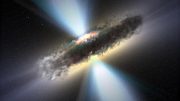



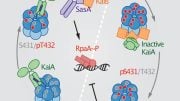
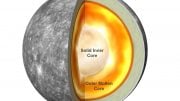

The universe does not do algebra, formula or fraction. The universe is geometrythe, and is the superposition, deflection, and twisting of geometric shapes.
According to topological vortex gravitational field theory, vortices (matter) and antivortices (antimatter) are formed simultaneously, with the same geometric shape but opposite directions of rotation. Countless topological vortices make spacetime motion more complex via the synchronous effects of superposition, deflection, and twisting. Therefore, there is so much data coming in from the LHC, the most powerful accelerator in the world, that recording it all has never been an option.
The rotation of topological vortices is spin. Spin creates everything, spin creates the world, spin creates the future. In the interaction of topological vortices, time is both absolute and relative,and physics often requires treating space and time at the same level. Spin occupies space, spin generates time, spin generates gravitation, spin generates energy, spin generates evolution. Each topological vortex is a quantum clock. Starting from the formation of topological vortices, precise timing begins.
The interaction and balance of topological vortices not only demonstrate the beauty of mathematics, but also change the way humanity understand nature. Studying topological vortices can greatly expand the boundaries of humanity cognition.
All observable movements in the physical world are inseparable from the interaction of topological vortices, including human observational behavior itself.
Today, we have already entered the era of the internet. With the help of artificial intelligence and big data, discussions on scientific knowledge have become open and transparent. However, a group of editors of so-called academic journals (such as Physical Review Letters, Nature, Science, etc.) are self righteous, self proclaimed, fooling the public, lack remorse, and mystifying themselves. They only care about their own so-called sufficiently high priority rating, general significance, discipline, novelty, etc., and do not care about what science and pseudoscience are.
Science and pseudoscience are not determined by a publication, an organization or a person, nor by you or me, but by mathematics the final say. Physical models must be based on mathematics or mathematical models in order to be scientific, convincing, and in accordance with natural laws.
The origin of geometry lies in the concerns of everyday life. The branch of geometry (mathematics) known as topology has become a cornerstone of modern physics. Topological vortex and antivortex are two bidirectional coupled continuous chaotic systems. They exhibit parity conservation, charge conjugation, and time reversal symmetry. The synchronization effect is extremely important in their interactions. The synchronization effect of the superposition, deflection, and twisting of multiple or countless topological vortices will make spacetime motion more complex. To understand this complex world, physics should respect the authenticity of topological vortex in low dimensional spacetime, rather than simply relying on a few formulas, numbers, or imagined particles.
Spin is a natural property of topological vortices. Spin is synchronized with energy, spin is synchronized with gravitation, spin is synchronized with time, spin is synchronized with evolution. The perpetually swirling topological vortices defy traditional physics’ expectations. One physical properties of topological vortices is them to spontaneously begin to change periodically in time, even though the system does not experience corresponding periodic interference. Therefore, in the interaction of topological vortices, time is both absolute and relative,and physics often requires treating space and time at the same level.
Low-dimensional spacetime matter is the foundation of high-dimensional spacetime matter. Low-dimensional spacetime matter (such as topological vortex) can form new material structures and derive more complex physical properties via interactions and self-organization. It is extremely wrong and irresponsible to imagine low dimensional spacetime matter using high-dimensional spacetime matter,such as a cat in quantum mechanics.
Science must follow mathematical rules. For example, the Standard Model (SM) is considered to be one of the most significant achievements of physics in the 20th century. However, the magnetic moment of μ particle is larger than expected, revealed by a g-2 experiment at Fermilab, suggests that the established theory (such as SM) of fundamental particles is incomplete. Furthermore, the SM omitting gravitation, it not involved the time problem and when the particle movement starts. Mathematics is the foundation of science. Physics must respect the scientific nature of mathematics and mathematical models. The SM must be based on mathematical models in order to be scientific, convincing, and in line with natural laws.
I hope researchers are not fooled by the pseudoscientific theories of the Physical Review Letters (PRL), and hope more people dare to stand up and fight against rampant pseudoscience.
The so-called academic journals (such as Physical Review Letters, Nature, Science, etc.) firmly believe that two high-dimensional spacetime objects (such as two sets of cobalt-60) rotating in opposite directions can be transformed into two objects that mirror each other, is a typical case of pseudoscience rampant.
If researchers are really interested in Science and Physics, you can browse https://zhuanlan.zhihu.com/p/643404671 and https://zhuanlan.zhihu.com/p/595280873.
The Physical Review Letters (PRL) is the most evil, ugly, and dirty publication in the history of science. Nature and Science have been influenced by Physical Review Letters (PRL) and are even more notorious. The behavior of these pseudo-academic publications has seriously hindered the progress and development of human society in science and technology.
I am well aware that my relentless repetition can make some people unhappy, but in the fight against rampant pseudoscience, that’s all I can do.
The Lone Ranger and the faithful Copy Paste
Thank you for browsing.
Best wishes to you.
I suspect, but am not certain, that the reference to “… twisted light or vortex beams” is more commonly called a circularly polarized laser beam. Can anyone confirm that?
Very good! you suspect, but are not certain.
Science cannot do without doubt, including God.
According to topological vortex gravitational field theory, what God plays is two spinning coin. However, until you see the coin, you will not be able to determine whether you are seeing a Left-handed or right-handed spin coin. At the moment of Creation, the geometric shapes of matter and antimatter are consistent. It is only the synchronous effect of countless “spinning coin” that makes spacetime motion more complex.
Therefore, if there really is God, symmetry is God. Symmetry creates the world, symmetry creates all things. The world we see and observe is asymmetric because we can never see or observe the entirety of the world.
The perpetually swirling topological vortices defy traditional physics’ expectations. Please believe in mathematics, geometry, and topology. If you are really interested in science, you can browse the comments of https://scitechdaily.com/science-simplified-what-is-quantum-mechanics/.
Wish you good luck.
According to topological vortex gravitational field theory, when two vortices rotating in the same direction are superimposed on the same plane, if the center of the vortex deviates, it may form an Elliptical Polarization. If the centers of the vortices coincide, it is possible to form accelerated rotating vortices.
If readers are really interested in science and physics, you can browse the https://zhuanlan.zhihu.com/p/595280873.